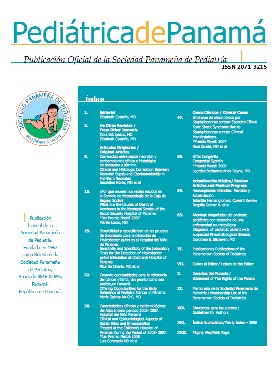Peutz-Jeghers syndrome as a cause of intestinal intussusception in children
1,
1
Peutz-Jeguers syndrome (SPJ) is a rare condition and its frequency is probably less than 1 / 50,000. It is characterized by the presence of potentially malignant hamartomatous polyps throughout the digestive tract associated with characteristic mucocutaneous pigmentations. Current data suggest the existence of at least 2 genes involved: STK11 (19p13.3), recently identi ed, is responsible for the disease in 70% of families. We describe the case of two adolescents with intestinal intussusception with a diagnosis of familial polyposis of Peutz Jeghers, requiring both surgical procedures
Show Affiliation
Authors
DOI:
https://doi.org/10.37980/im.journal.rspp.20181628Keywords:
Peutz-Jeghers, Intestinal intussusception, polyposis, adolescentAbstract
Intestinal intussusception occurs more frequently in the infant younger than 2 years, with a peak between 5 and 9 months of age. In the vast majority of cases it is idiopathic or of unknown cause, probably secondary to a viral infection that causes a growth of the intestinal lymphatic tissue. Only in 2-8% of the patients an anatomical alteration as cause of the intussusception is demonstrated (Meckels diverticulum, polyp). It is called secondary intestinal invagination, which usually occurs in children under 3 months or older than 3 years.Peutz-Jeguers syndrome (SPJ) is a rare condition and its frequency is probably less than 1 / 50,000. It is characterized by the presence of potentially malignant hamartomatous polyps throughout the digestive tract associated with characteristic mucocutaneous pigmentations. Current data suggest the existence of at least 2 genes involved: STK11 (19p13.3), recently identi ed, is responsible for the disease in 70% of families. We describe the case of two adolescents with intestinal intussusception with a diagnosis of familial polyposis of Peutz Jeghers, requiring both surgical procedures
Downloads
Published
2020-11-09
Issue
Section
Case reports
License
Copyright (c) 2020 Pediatric Journal of PanamaDerechos autoriales y de reproducibilidad. La Revista Pediátrica de Panamá es un ente académico, sin fines de lucro, que forma parte de la Sociedad Panameña de Pediatría. Sus publicaciones son de tipo gratuito, para uso individual y académico. El autor, al publicar en la Revista otorga sus derechos permanente para que su contenido sea editado por la Sociedad y distribuido Infomedic International bajo la Licencia de uso de distribución. Las polítcas de distribución dependerán del tipo de envío seleccionado por el autor.






